Bathroom mosaic tiles: features and tips for choosing
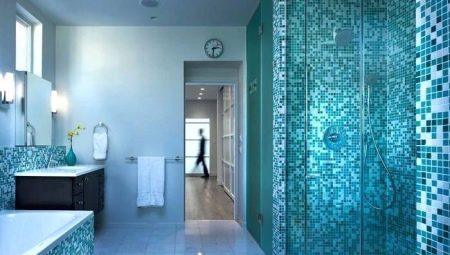
Bathroom mosaic tiles are considered one of the best design solutions; they look equally good in a spacious room and in a small room. With its help, you can visually correct the curvature of the walls and the height of the ceilings, create volume or give depth to the chosen decor option.
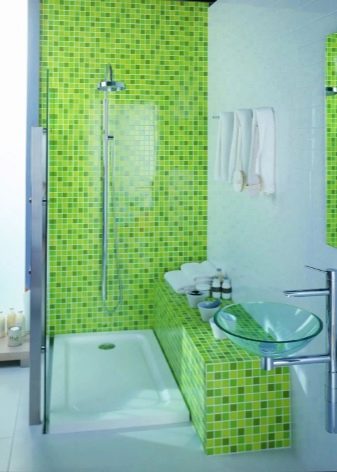

The design of a room with mosaic tiles on the floor or walls allows for the use of various styles and textures of the material. And the variety of options for choosing such a finish can amaze even an experienced decorator.
Before the coating is chosen, it is worth paying attention to the available variety of its types, taking into account the characteristics of the material - only in this case it will be possible to count on a good result.
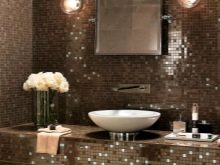
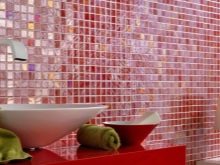
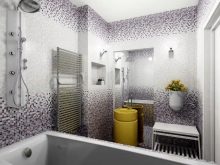
Peculiarities
Bathroom mosaic tiles must have certain characteristics that allow them to easily endure regular contact with detergents, moisture, steam. That's why you can find it far from the cheapest segment of the market; budget brands produce such products extremely rarely.
The main difference between mosaic tiles is the small format of their elements. The module consists of many small pieces of the same color or contrasting tones.
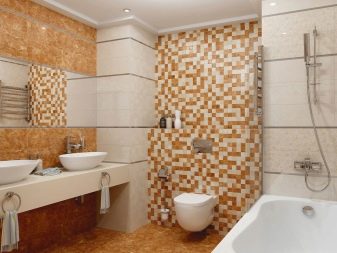
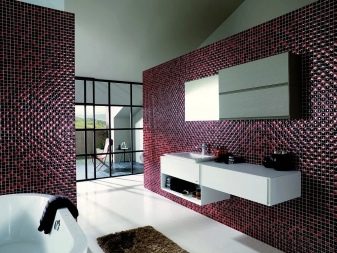
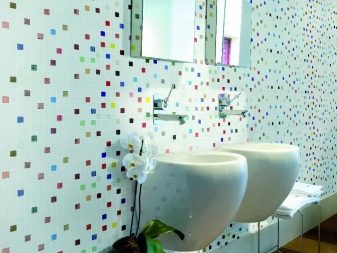
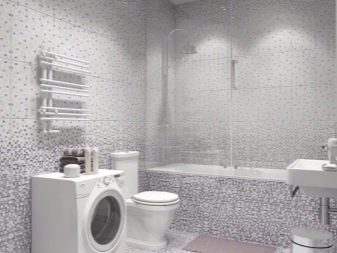
The use of mosaics is important for finishing the surfaces of walls, floors; you can use it to decorate ceiling structures. Small-format blocks look especially impressive on a large area, where they can be used to create original panels and whole paintings.In addition, with these modules it is easy to finish architectural elements of complex shape - arches, niches, ledges, sides.
Mosaic tiling works well for creating vertical or horizontal friezes, providing room zoning or visual correction.
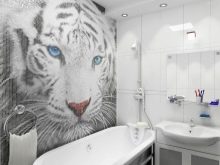
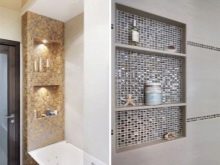
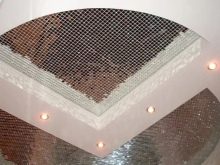
The variety of materials also matters. If the tile is mainly represented by ceramic modules, then the mosaic can be glass, stone and even plastic. The choice of options is practically unlimited.
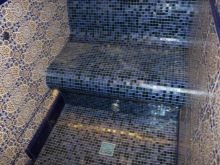
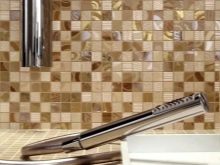
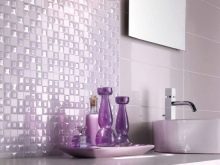
Views
All types of mosaic tiles can be divided according to their texture and type of attachment to the surface. Manufacturers offer matte and glossy elements, mirror options. Also, mosaic tiles can be structural and embossed, have a spongy texture with pronounced pores.


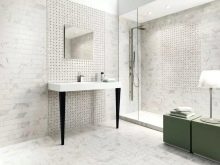
Among the manufactured products are narrow border elements or full-size matrices and meshes.
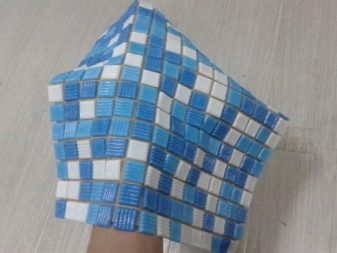
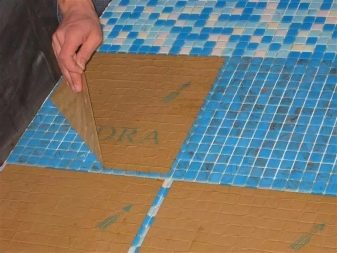
The size of the mosaic tiles on sheets of self-adhesive paper is usually 30 × 30 cm. In addition, a mesh stretch can be used to fasten the modules together. Its dimensions are larger, they can be 50 × 50 cm and more, which makes installation work much faster and more efficient.
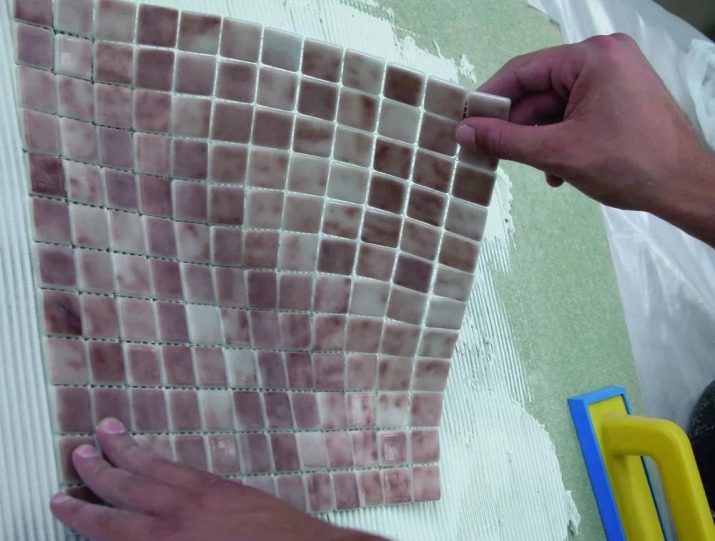
Self-adhesive paper base of mosaic tiles is the simplest and most convenient to install.
But it requires a perfectly flat base, otherwise the sheets attached to the walls can quickly separate from the surface. The base can be moisture-resistant drywall or concrete, carefully leveled with finishing plaster compounds. To glue the mosaic, it is enough to mark the base and fix the elements on the prepared glue solution, the paper part of the sheet is removed at the final stage of installation.
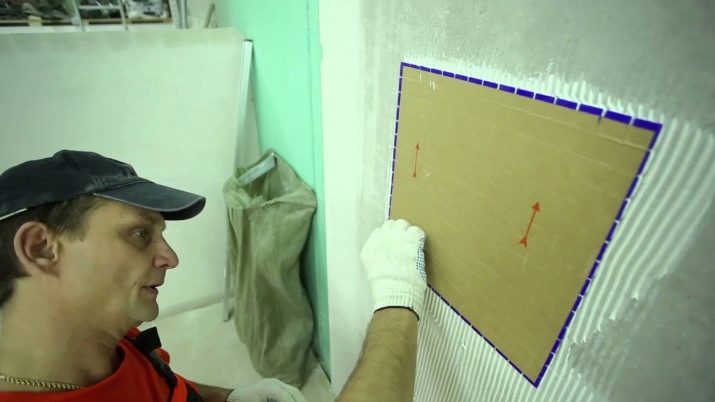
The grid on which the mosaic is placed can also be different. The most convenient is polyurethane, which is able to retain its properties in contact with a humid environment.
But it is permissible to apply and metal, durable galvanized... When choosing a mosaic, you should pay attention to the reliability of its attachment to the mesh - with free sagging, the elements should not move away from the base. There is no need to purchase gauze-based tiles - they are poorly suited for rooms with high humidity and are not so easy to install with glue.

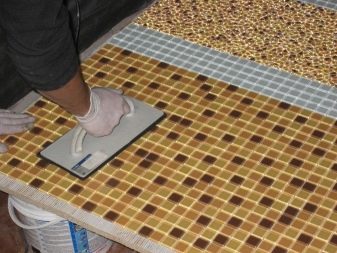
It is also worth considering the following points, dividing mosaic tiles into separate types.
- Product grade. The strongest modules of the 1st grade are marked in red. According to the international classification, blue is the 2nd grade, green is the 3rd, the least durable, it is suitable only for flooring.
- Appointment... Mosaic matrices can be floor-standing or wall-mounted. The wall decoration packaging will have a palm icon. The floor is marked with a footprint.
- Chemical resistance. There are 5 product classes, the most suitable for the bathroom are those marked with AA or A and are able to withstand contact with moisture, steam, household cleaning products. The package must contain a marker in the form of a flask.

Considering all these points, it is easy to navigate the existing types of tiles and understand which option is suitable for finishing the bathroom.
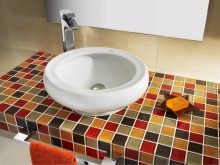
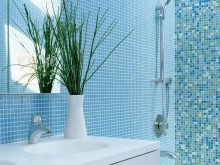
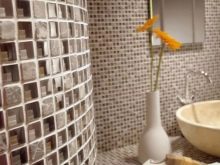
Materials (edit)
Among the materials used for the manufacture of mosaic tiles, the most popular can be distinguished.
Plastic
A budget option, which under certain conditions, for example, with a glossy finish and mother-of-pearl splashes, can look quite decent. Plastic tiles are not porous, are similar in properties to tiles, and are inexpensive. But its use is limited to the surface of the walls - on the floor, the coating will be too fragile.
It is worth choosing a mosaic tile made of plastic if you need to make budget repairs, but you don't want to use very simple decor options.
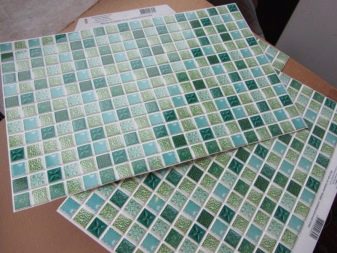
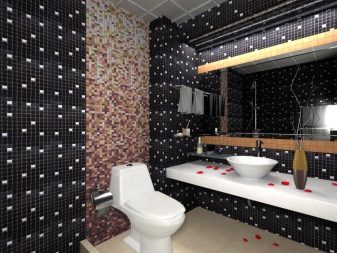
Metal
The basis of such a mosaic tile is plastic, on top of which metal plates are laid.
In the interior of the bathroom, the use of such a decor is very limited, since upon contact with a humid environment, the coating can show signs of corrosion, and it quickly loses its decorative effect.
But in small quantities, tiles for copper, brass, bronze can be used in decor, as a border or frieze.
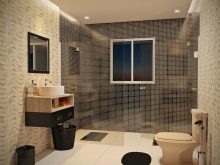

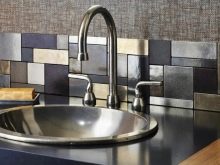
Ceramics or tiles
The most popular mosaic finish is durable, varied in design, texture, and colors. Ceramic mosaic tiles are made from ordinary or white clay and have all the characteristics of this material.
Such modules are well suited for decorating floors, walls, they are resistant to abrasion, easy to install on uneven wall surfaces.
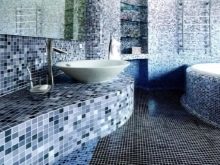

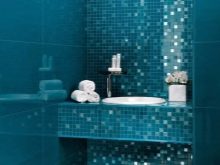
Ceramic mosaics are often included in the collections of tiles from the world's leading manufacturers, decorated in the same style or harmoniously complementing the main line.
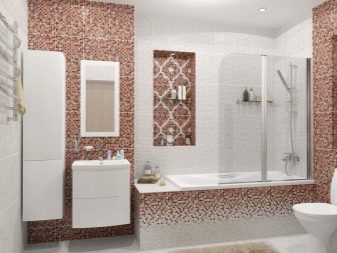
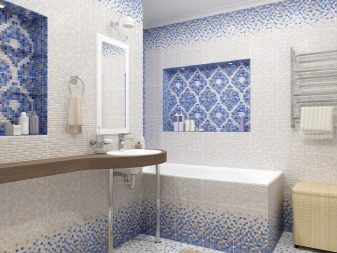
Smalt
Artificial glass, obtained with the use of metal oxides, acquires an original deep color and is perfect for making mosaics.
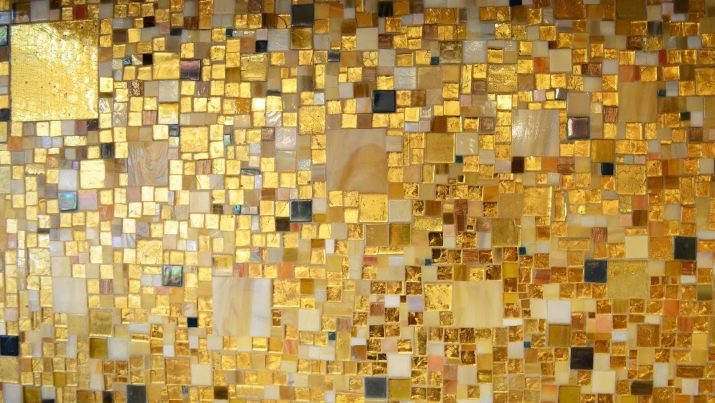
The material is more difficult to manufacture and more expensive. But such mosaic tiles are highly prized for their decorative properties and are especially loved by Mediterranean-style interior designers, where they convey the depth and splendor of colors.
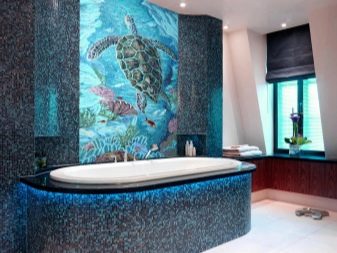

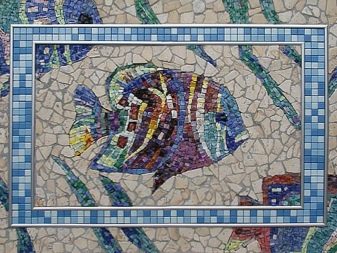
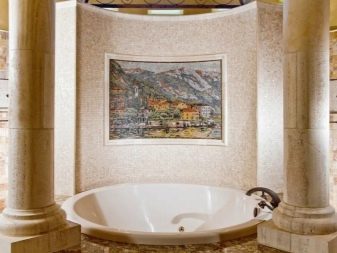
Glass
The original glass mosaic is more expensive than usual, but it looks much more interesting and respectable. Its shape is rounder due to careful processing of the edges. Smooth transparent mosaics of different shades are produced, as well as textured rough, supplemented with various inclusions.
The glass mosaic is based on high-quality silicon sand, which undergoes a high-temperature firing process, the material is stronger than ordinary window glass.
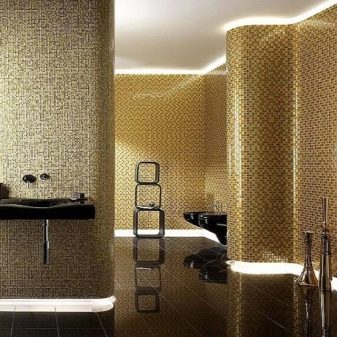
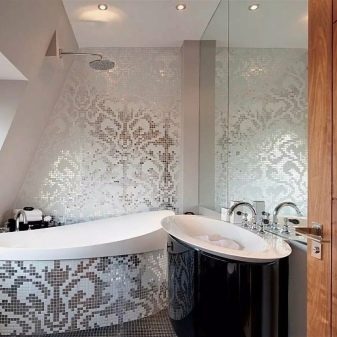
Mirror
One of the most expensive mosaic tile options, it is suitable for luxury designer bathrooms. Can be found patinated, cracked, aged versions or multi-colored, black, red solutions. Mirror mosaic looks good in high-tech interiors, but can be used in other styles, the only limitation is it should be a bright accent, not a dominant component of the design decision.
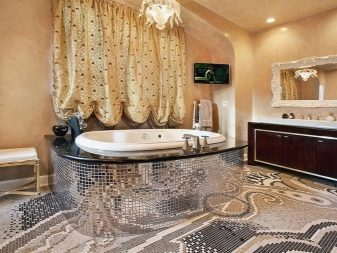
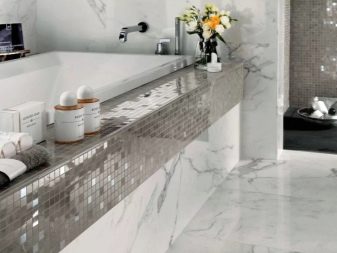
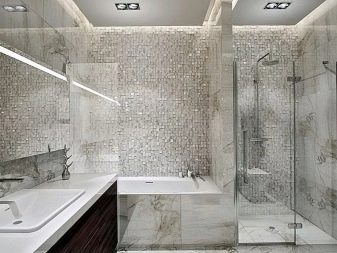
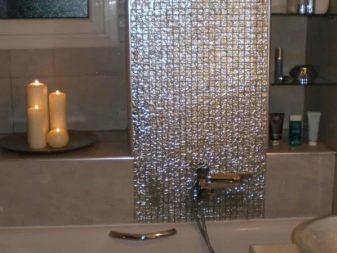
Natural stone
Marble, granite, travertine, jasper, onyx - all these types of minerals and rocks can be found in the form of mosaics. Such decor is always more expensive than usual, it contains true nobility and respectability.
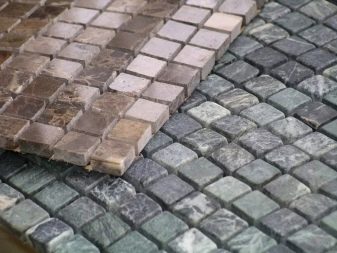
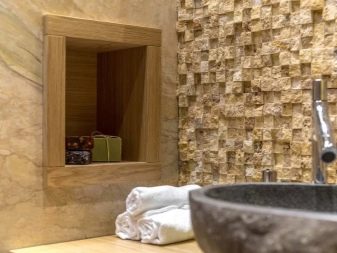
Beautiful stone panels, floor and wall cladding made of this material do not have excessive brightness of colors and create an atmosphere of peace and relaxation in the interior of the bathroom.
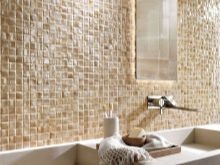
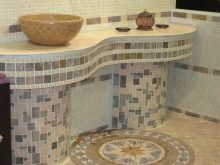
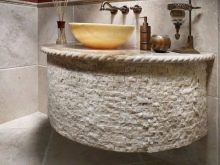
Fake diamond
Imitation of natural minerals is a good solution, if you want to get the original interior design of the bathroom, but the budget does not allow you to purchase material of natural origin.
In terms of their structure, many analogs (for example, quartz agglomerate) are not inferior to granite, they are also resistant to mechanical and shock effects.
Acrylic is cheaper and less durable, but it looks pretty attractive.
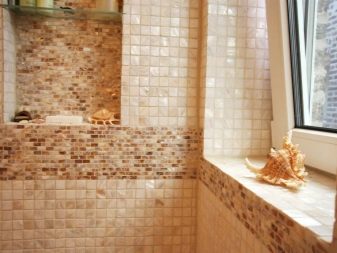

These are the main materials that mosaics can be used in the bathroom. But decor options made of wood or made of other non-moisture resistant materials are prohibited here.

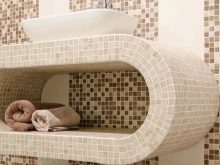
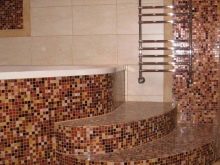
Shapes and sizes
Mosaic is most often used in combination with ordinary tiles, becoming an original accent against the background of larger modules. If such a combination is to be used, the shape of small elements must be selected similar to the main finish.
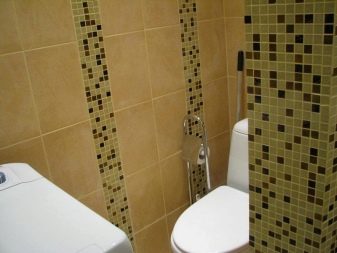
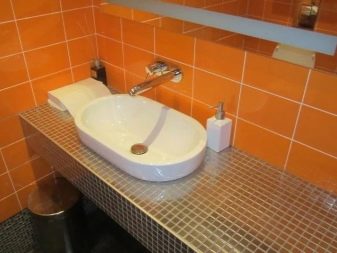
Among the commercially available mosaic tile options, the following varieties can be distinguished:
- square;
- hexagonal;
- rectangular;
- diamond-shaped;
- round;
- asymmetrical.
The most common mosaic is with square-shaped elements.
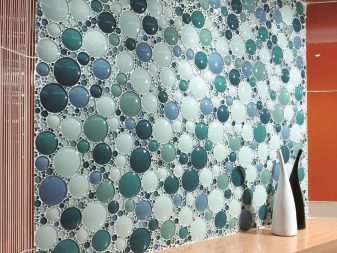
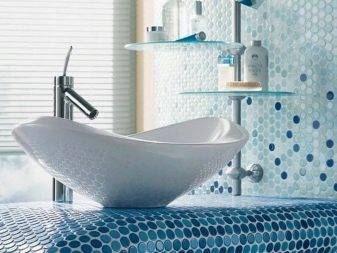
As for the sizes, the size 1 × 1 cm is best suited for creating panels and ornaments, framing curvilinear interior details. Larger tiles of 2x2 and 5x5 cm are used on the floor or to frame plainly embossed wall sections.
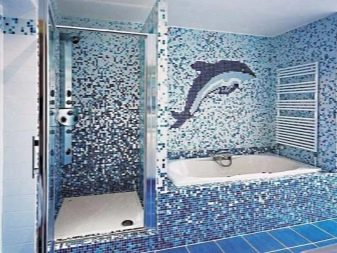
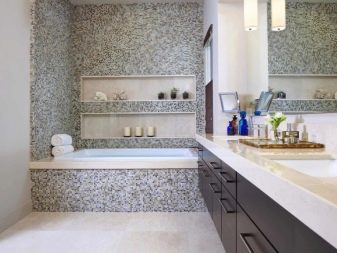
The thickness of the mosaic is usually less than that of classical ceramics, ranging from 0.3 to 1.2 mm, all options up to 0.6 mm are suitable for walls. But when choosing a ready-made set of elements from one collection, you don't have to worry about the difference in heights - both the tile and the decor will definitely be made to the same level.
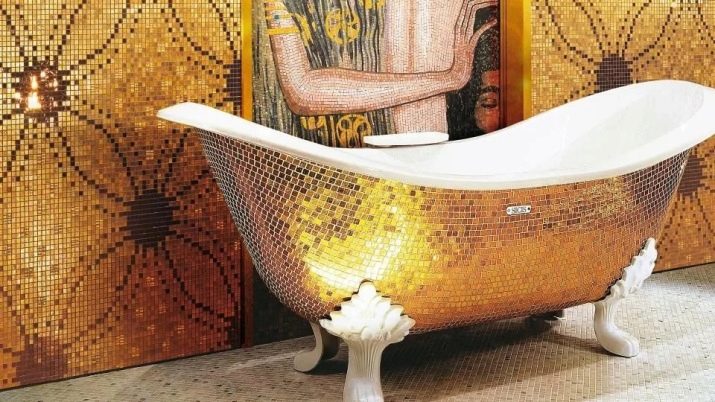
In most cases, the mosaic tiles are fixed on 30x30 cm matrices or A4 rectangular sheets. They are easy to use, suitable for use and cut to size.
Colors
The color range of mosaic tiles is wide enough and allows you to implement the most unusual design ideas. Can be used plain options or contrasting combinations.
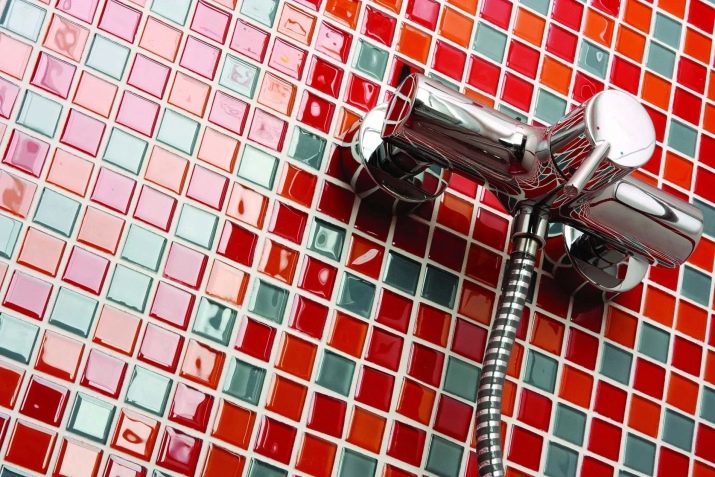
The most commonly used color combination techniques are certain.
Monochrome
Monochromatic mosaics are considered not so spectacular. But if this is an original mirror panel or a portal framing in the wall, such a solution may turn out to be a winning one. Solid color mosaic walls or floors blend in well with aesthetics minimalism. In the interior modern only one wall can be monochrome.
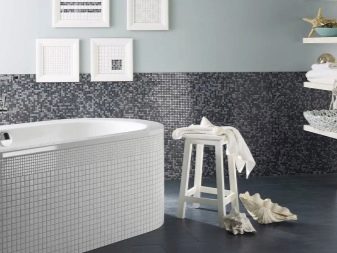
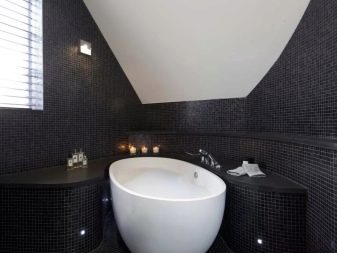
Background
The mosaic base can be a good addition to the original panel in the center or artistic painting. Background mosaic tiles are often used in combination with plumbing fixtures of non-standard colors (gold, silver, decorated with rhinestones), favorably shading them and not drawing attention to themselves.
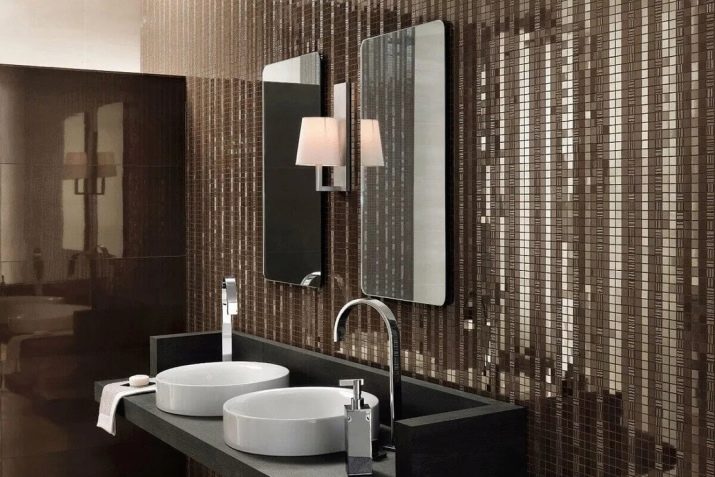
Gradient
Color change with a gradual transition of shades from light to dark or vice versa. Stretching can be done vertically or horizontally. Gradient mosaic tiles are good for visually expanding or increasing the height of ceilings in a room.
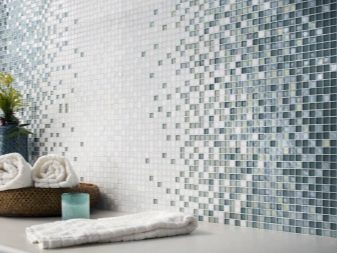
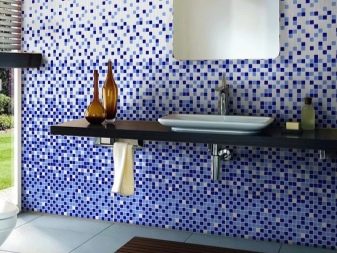
Mix
Assumes a combination of elements of the same size, but different in color. They can be arranged randomly or in a certain order. There must be more than two colors, otherwise you will get a domino effect.
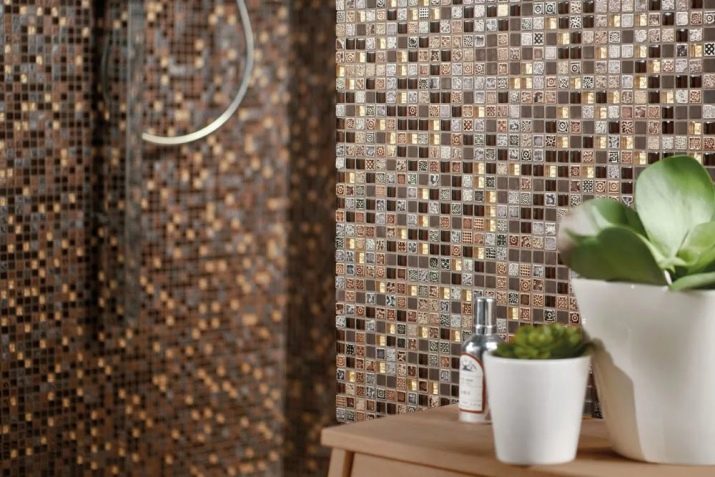
The choice of color should correspond to the style of the bathroom, its spirit.
White, gray, black gamut - individually and in combination, suits the Scandinavian style, minimalism, hi-tech. But it can also be found in country interiors, as patchwork patterns. And in the Art Nouveau style, the combination of white and black has long become a classic.
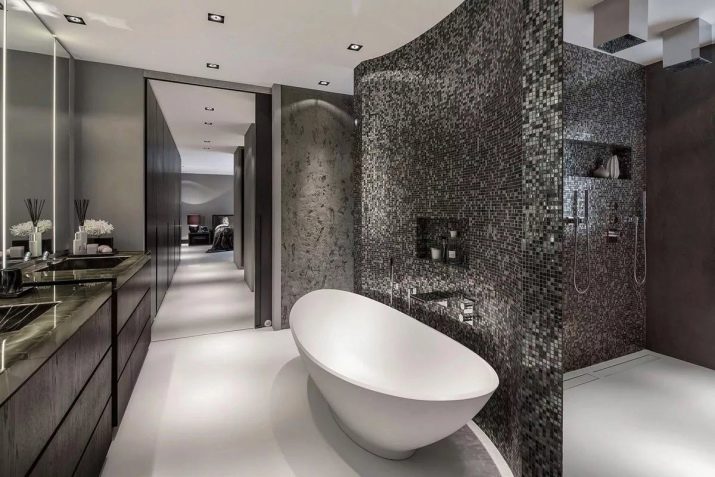
It is worth paying attention to the fact that the color scheme in the design of the bathroom has its own traditions of choice.
For example, gold mosaic tiles are usually used to frame areas of a room with complex geometric parameters. It is framed by arches, fonts, niches. But the totally golden color may look too accent; it is better to leave it as a nice addition to the overall design of the space.
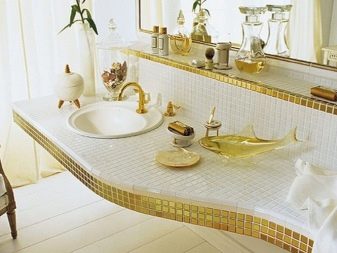
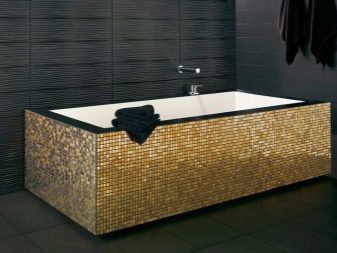
The smaller the room, the lighter colors are chosen for its decoration. The mosaic for such a bathroom can be marble or monochromatic, in milky, lemon, pastel pink, mint, light beige.
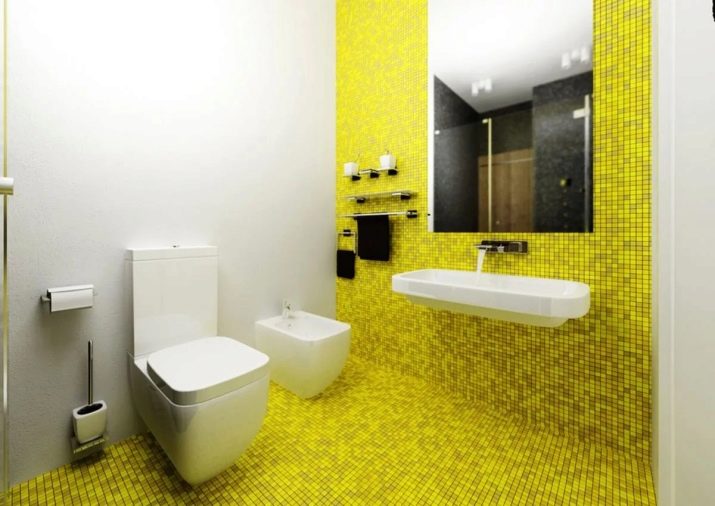
The premise of a spacious bathroom allows more room for the application of design solutions. Here will be appropriate deep blue and juicy green gamut. Calm brown or laconic black mosaic tiles also look good in a bathroom, which can easily accommodate not only a bath, sink and toilet, but also the necessary pieces of furniture.
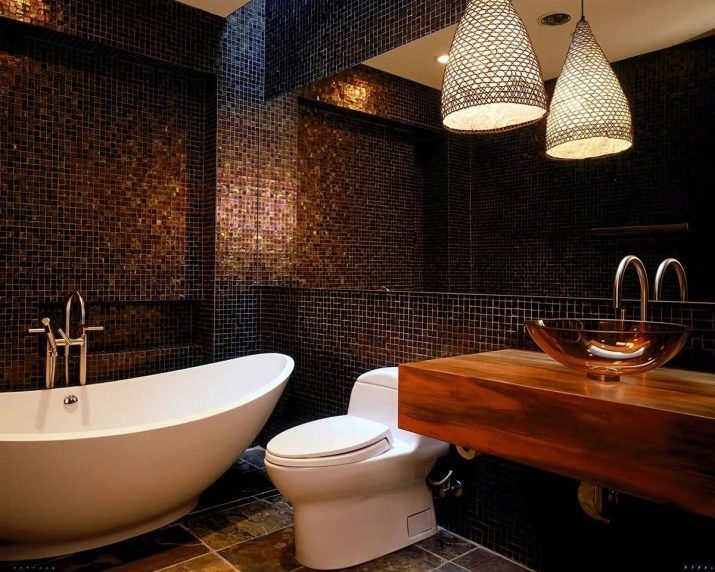
Deserves special attention a room in which a significant part of the area is occupied by a shower room. Here, the mosaic finish can separate the different functional areas with narrow horizontal or vertical stripes.
In the decor of such a bathroom, it is customary to combine mosaic floors and walls in contrasting colors.
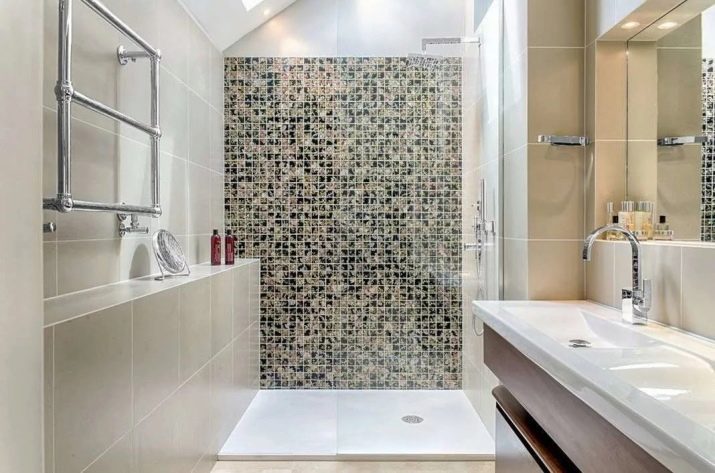
White and blue, gray and aqua, lemon and lime components harmoniously complement each other in the interior. And here it is better to refuse from too active red color in the bathroom; in a mosaic design, it may turn out to be too oppressive.
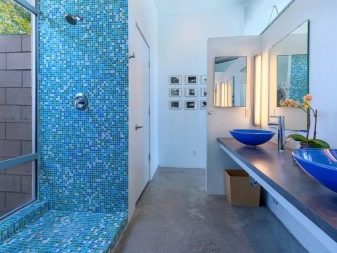
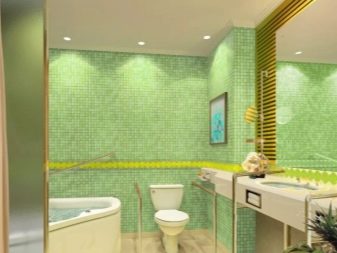
Images and patterns
The original design is one of the reasons why the choice is made in favor of mosaic tiles. The bathroom area is usually small, so it manages to implement ideas that cannot be realized in larger rooms. Mosaic panels can continue the general theme of the decor or be an original detail that attracts attention. You can enhance the effect using mirrors or contrast with large tiles.
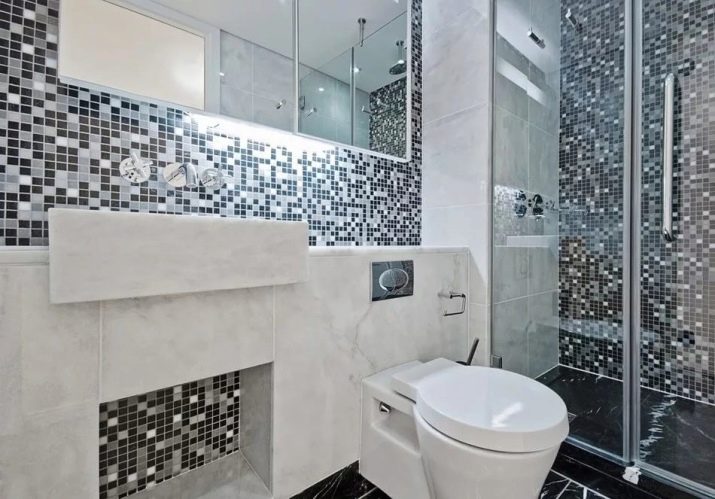
Besides, mosaic patterns can dilute the main finish... So, the floor "under a tree" can be decorated with an original border. In a vertical plane, on a wall or in a niche, floristic compositions from mosaic tiles look spectacular. Moreover, it is not at all necessary to use exclusively floral ornaments. Juicy green stems of young bamboo or Japanese sakura look no less attractive.
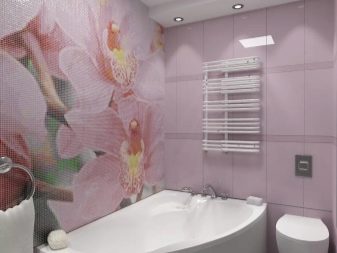
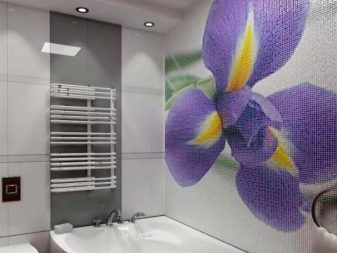
A horizontally oriented mosaic panel most often depicts a seascape or a sunset. Placed in a niche or located along the wall near the bath, the mosaic visually expands the space. Two-color pixel paintings with different subjects are also popular.
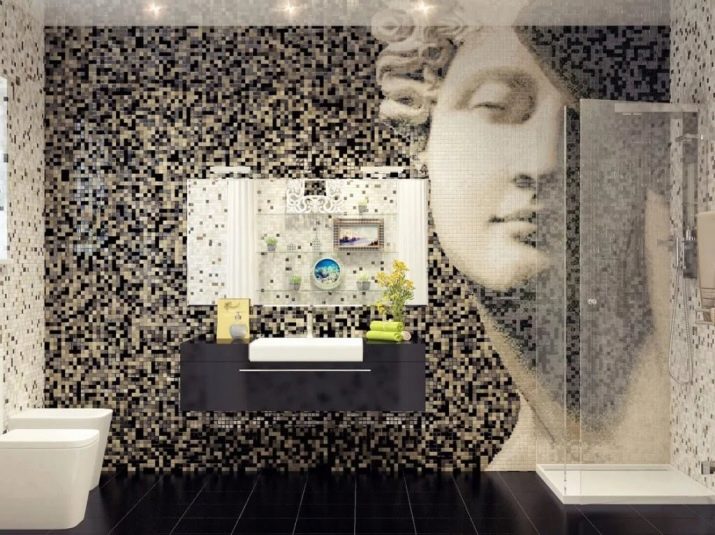
Another relevant option is animalistic mosaic panels. The image of dolphins, tigers, pandas and other animals requires some support in the interior. You can use predatory or marine colors and prints, frame the panels with juicy grassy decor.
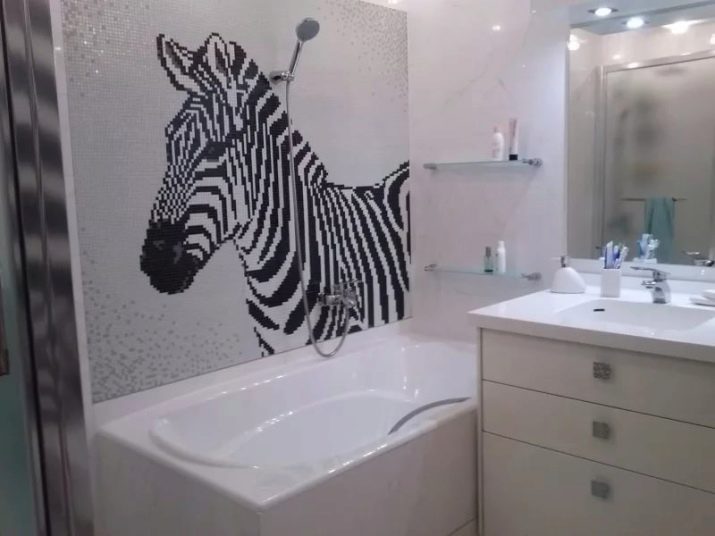
If we talk about patterns for mosaic tiles, then the most popular are ornaments:
- in patchwork style;
- ethnic motives;
- repeating geometric shapes;
- waves or zigzags;
- brickwork;
- honeycomb;
- river bank.
Fashion changes periodically, and new trends emerge at the peak of popularity. That is why, when choosing various ornaments for mosaics, you should first of all focus on the chosen style and current collections.
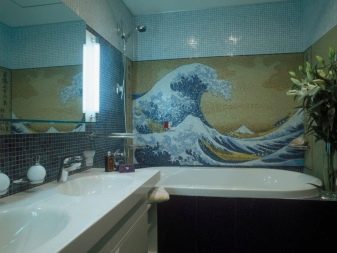
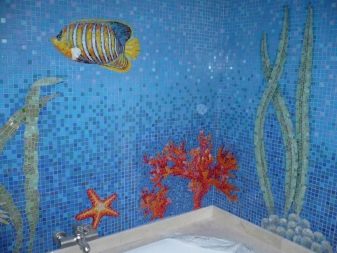
Style solutions
Depending on which style is chosen for decorating a bathroom, an interior decorated with mosaic tiles can look strict and laconic or luxurious and bright. Popular styles can be distinguished.
- Minimalism. Small light tiles of the same tone or a combination of milky and light gray tones will be appropriate here. The mosaic should not draw attention to itself; the best solution would be to use it as a background.
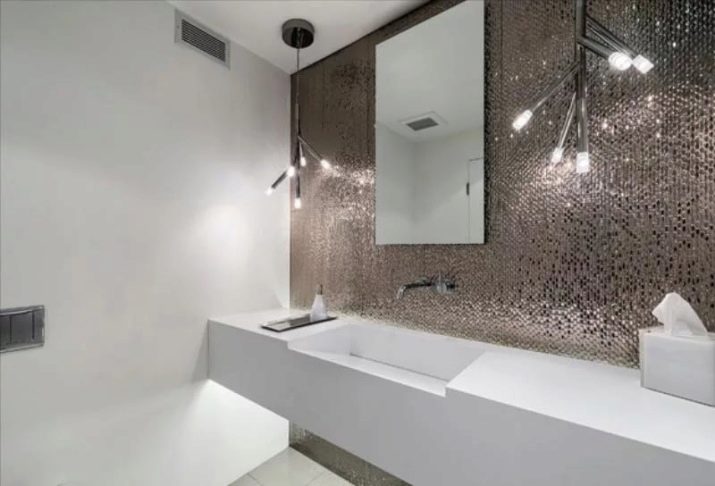
- High tech. Black or white mosaic tiles with glossy sheen on the walls will harmoniously fit into the interior with an abundance of chrome-plated metal and state-of-the-art sanitary ware.
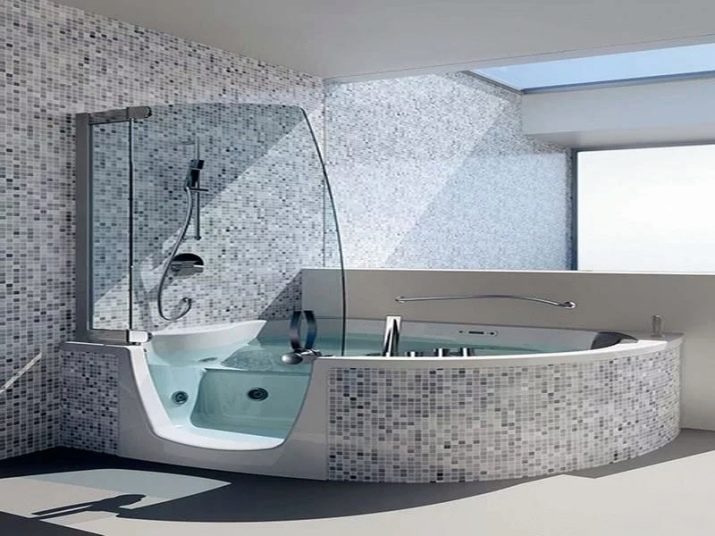
- Country... Large-format mosaic tiles are used here, complex shapes - hexagonal or round, imitation of pebbles and other natural materials is possible.
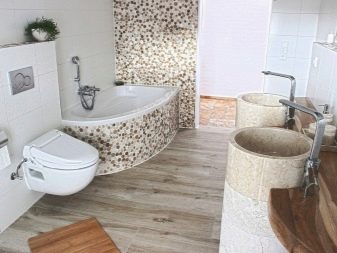

- Loft... The gray concrete-like mosaic on the walls looks interesting and unusual. A natural stone finish with a deliberately rough surface treatment will also be appropriate here.
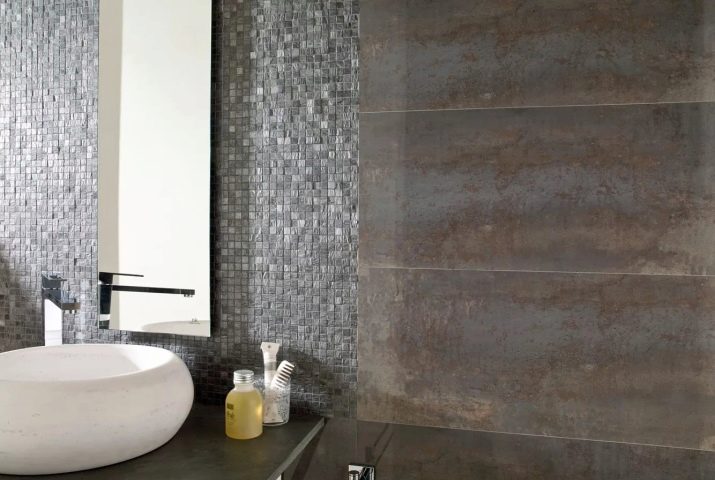
- Art Deco. In this style, combinations of white and gold mosaic tiles are simply irreplaceable. She will give the interior the necessary chic, emphasize the uniqueness of the decorative solution.
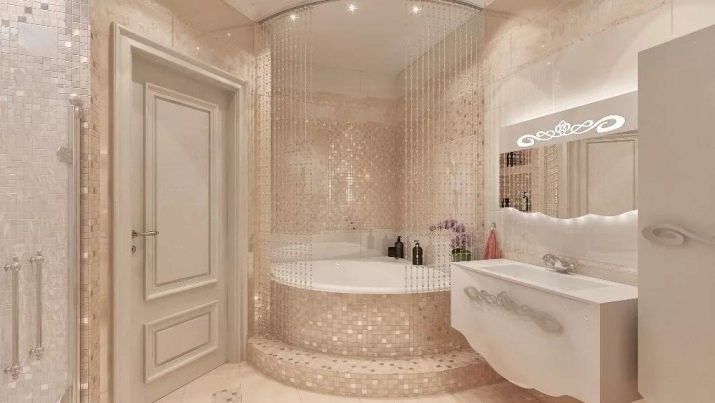
- Vanguard. In a bathroom in this style, the walls of mosaic tiles look organic in the most incredible and rich color combinations. Light green, orange, yellow, purple, raspberry and ultramarine tones form a whimsical combination that can transform the most conservative layouts.
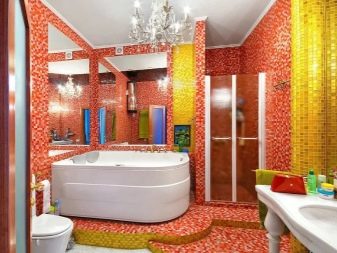
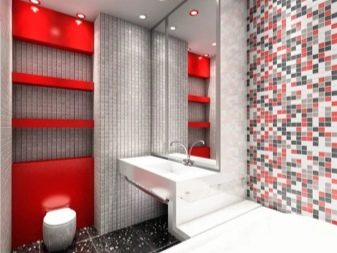
- Mediterranean... Mosaic tiles of all shades of blue and original panels with drawings of a marine theme are used here. Pure white is usually chosen as a pair to azure.
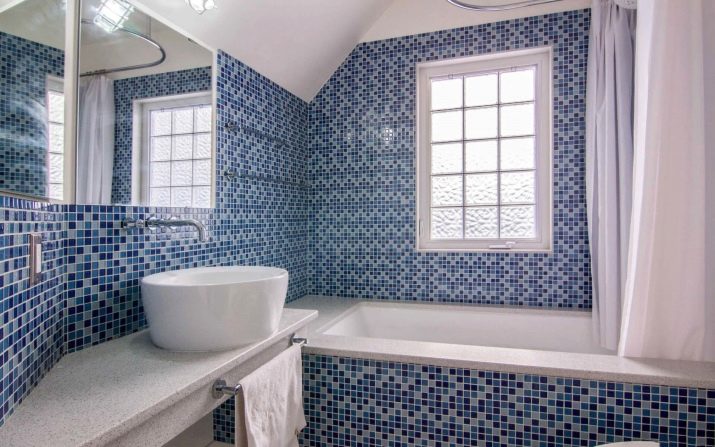
- Oriental. Small intricate ornamentation, for which interiors in India, China, Iran are famous, in this case can be conveyed most accurately. Natural stone or smalt, glass mosaic are suitable for decoration.
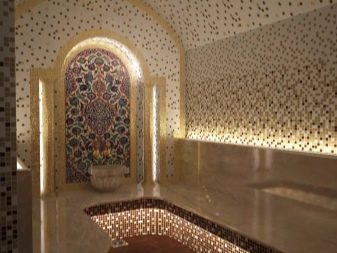

Successful combinations
It is quite easy to find successful combinations for the bathroom interior using mosaic tiles. Here are the options that are used the most.
- One mosaic accent wall. It can be variegated or monochromatic, in any case, such a detail will not be overlooked.
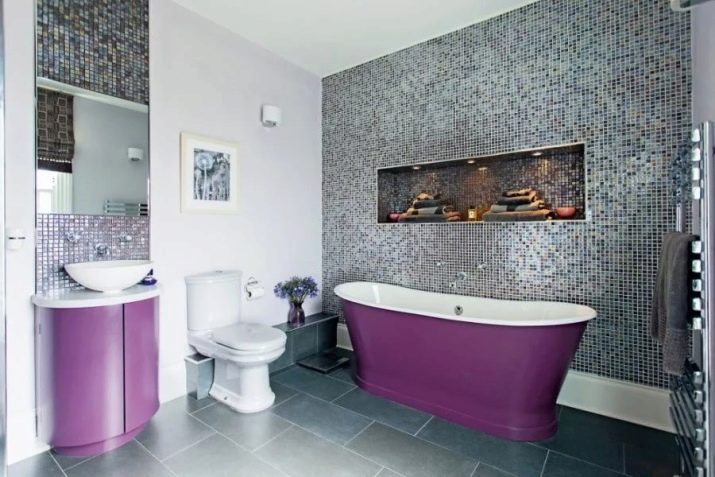
- Apron over the sink. Framed with classic tiles or in combination with decorative moisture-resistant plaster, painted walls, it will help to frame the mirror beautifully, bring fresh notes into familiar design solutions.
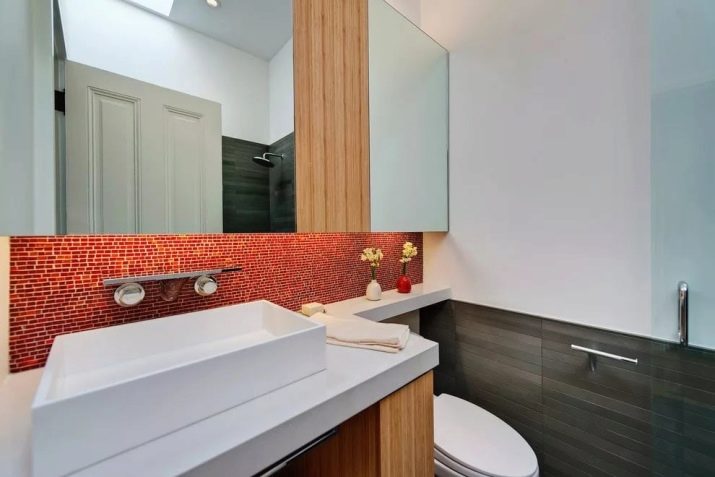
- Mosaic carpet. If the area of the flooring allows, you can lay out its central part with mosaic tiles, and leave a single-color tile around the perimeter, similar or contrasting in texture. If you choose pebble tiles for the "carpet", you get a pronounced massage effect.
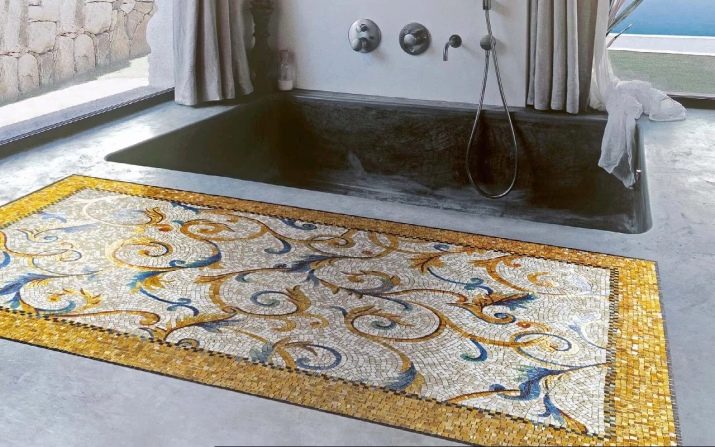
- Finishing the shower area. Here it is worth using textured rough mosaic with wide jointing underfoot and smooth materials on the walls.
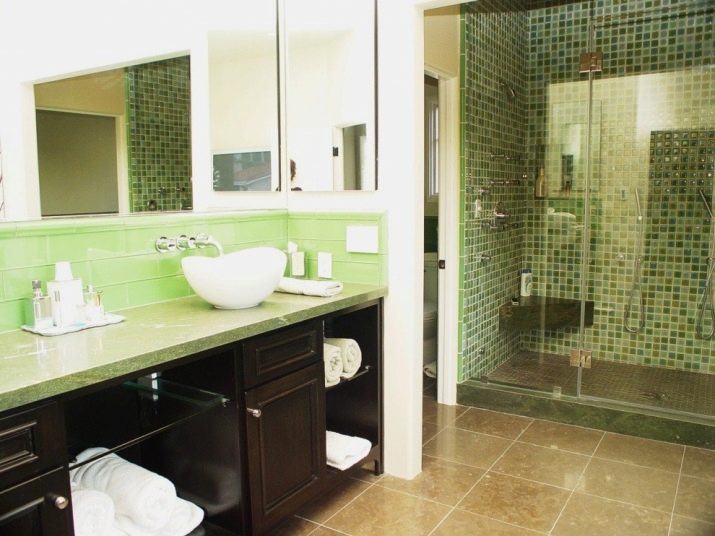
- Mosaic decoration of furnishings. It can be used to inlay not walls or floors, but a dressing table, a dressing table, the outer surface of a bathtub, toilet bowl or bidet. In the shower, you can tiled with mosaic tiles on a small bench for seating and enjoy the water treatments in comfort.
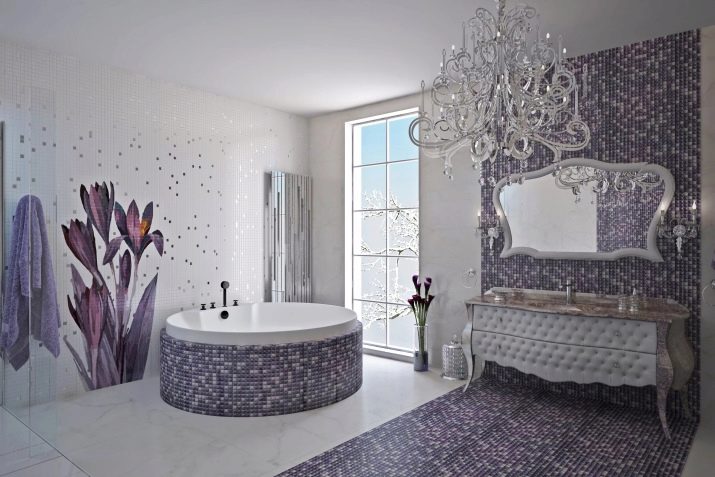
How to choose?
When choosing a mosaic, it is very important to consider a number of points. The most relevant recommendations can be highlighted.
- Careful selection of manufacturers. The best ceramics are Spanish and Italian. Quartz agglomerate and artificial stone can be chosen from Chinese. Glass tiles can be found in Russian and Italian brands. In any case, it is better to choose a mosaic from well-known firms, otherwise you may encounter low quality goods.
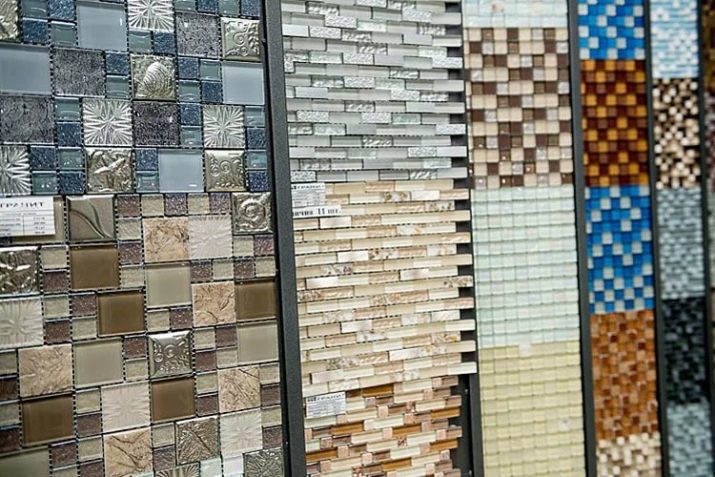
- Accurate calculation of the coverage area. If a complete facing of the room with mosaic tiles is planned, the area of the floor, wall, ceiling surfaces is considered and a margin of about 10% is laid for each type of coating.
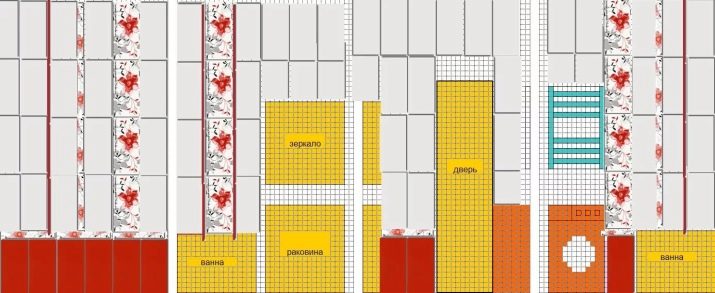
- Obligatory consideration of the size of the bathroom. For a small room, you should choose light and pastel colors - white, milk, cream, mint, blue. A spacious room can be decorated with darker and brighter mosaic tiles. The size of the chips - individual pieces - also matters. The smaller the area, the smaller they should be.

- Surface texture. For the floor, it is better not to choose surfaces that are too slippery and smooth. The tile here should be quite textured, rough. Smooth glossy or textured elements can be laid on the walls. It is customary to make the ceiling matte, this gives it depth.
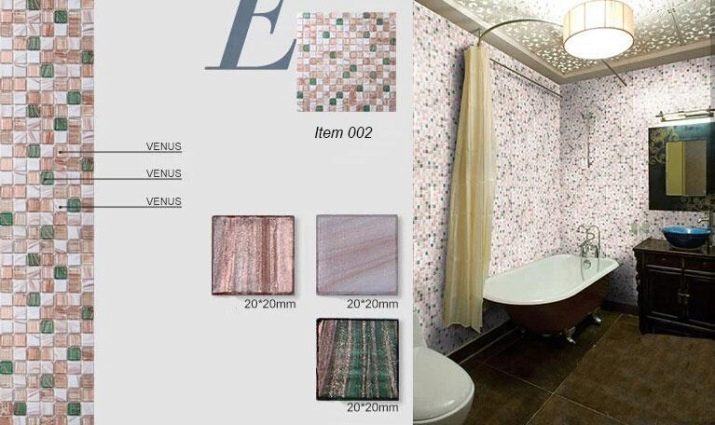
Cladding methods
Among the used methods of facing with mosaic tiles, there are combinations that allow you to harmoniously fit such an unusual decorative element into the space. If the repair has already been done, but you want an update, you can only finish one accent element. Mosaic tiles look good as a bathtub screen decoration or an acrylic model outside framing.
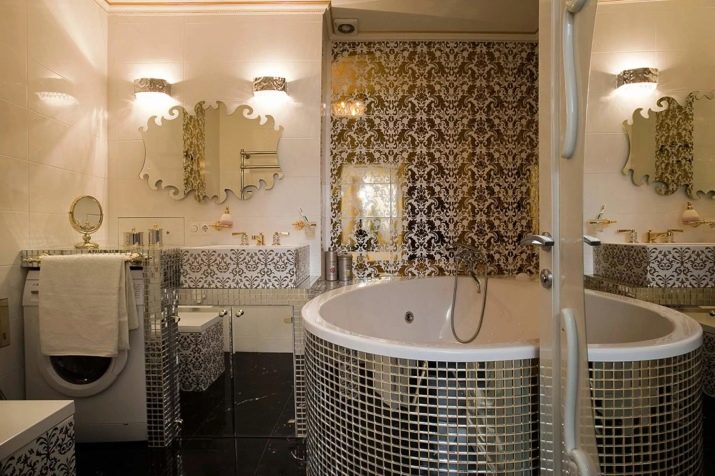
If room size allows, you can choose repeating mosaic motifs for floor and wall finishes.
For example, choose ethnic ornament in patchwork style, large hexagonal modules in the form of a honeycomb. Cladding options, in which the same tile continues the line of the wall on the floor, also look very good. This technique is often used for space zoning.
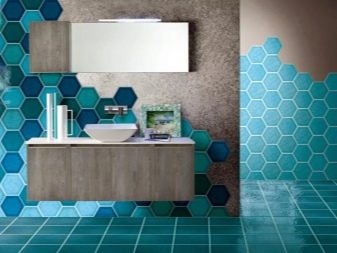
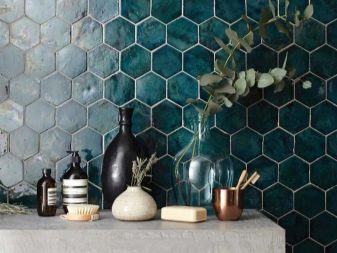
Mosaic tiles on the shower floor can be complemented by a matching mirror frame. Near the bathtub, around the washbasin, the toilet bowl, a contrasting border can be made around the perimeter of the floor covering.If the mosaic is laid on the wall, it can be used to balance the imperfections of the room by simply trimming the corners and protrusions with it and turning them into a design element. This way you can emphasize beams, niches, thresholds, frame a panel or a shelf.
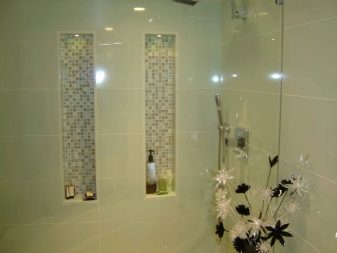

If the bathroom has a podium or steps, small mosaic tiles on the underside areas will become an interesting decorative accent... Light - milky or white - wall decoration will look richer with pearlescent accents, horizontal or vertical stripes with a metallic or mirror shine effect.
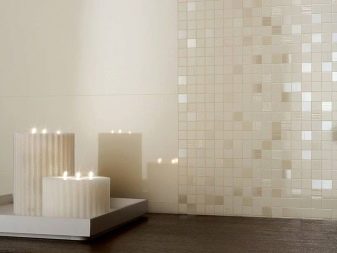

When choosing a styling method, you can use interesting tricks.
- Direct arrangement of elements. All lines are parallel to each other, matrices or sheets are placed end-to-end to form clear geometric coincidences.
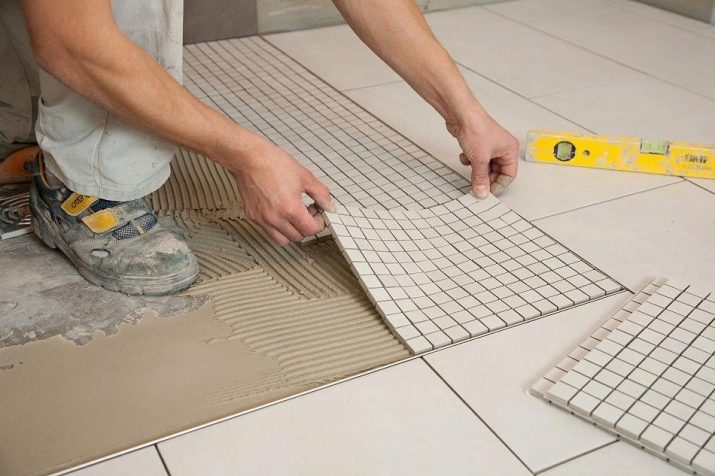
- Corner mounting. In this case, the modules are stacked in the form of a rhombus, butted diagonally. Ready-made solutions are available or rectangular dies can be used for this installation method. Typically two colors of mosaic tiles are used in diamond laying.
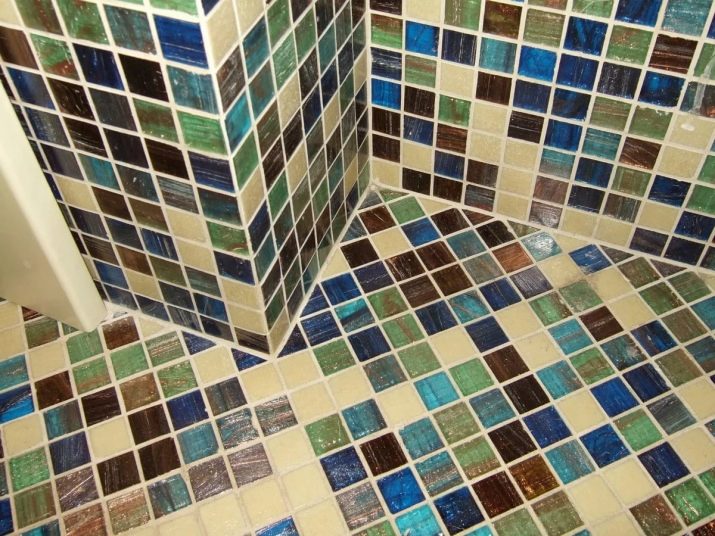
- Chess arrangement of elements. It is carried out without displacement of the seams, using contrasting colors. Usually there are no more than two of them and the result resembles the arrangement of cells on a chessboard. This type of installation is often recommended for 3D mosaics.
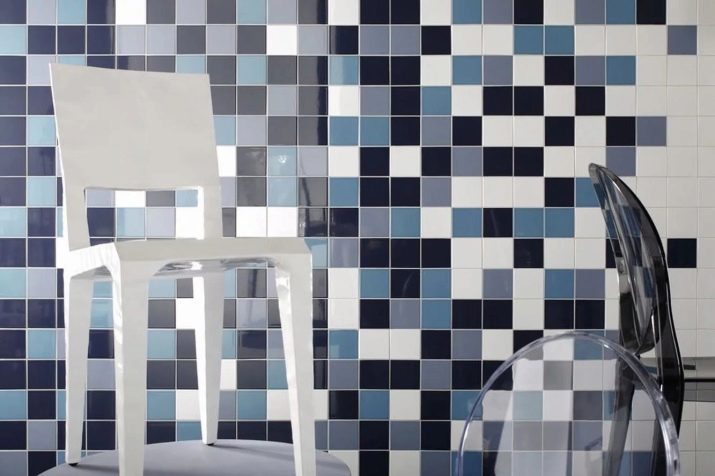
- Parallel stripes. In this case, a mosaic of different colors and textures replaces each other, being located parallel in a vertical or horizontal plane.
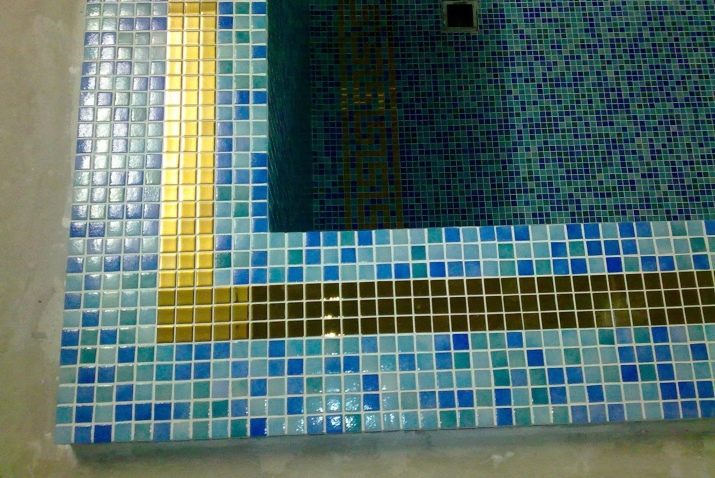
- Offset. It should be 1/2 part of one chip - in this case, you can visually expand the space, make it more voluminous and deeper. You can also cross lines for interesting visual effects.
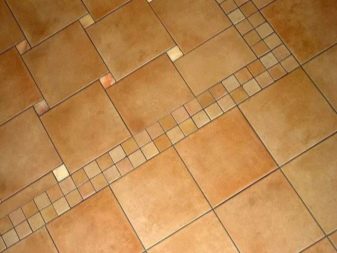
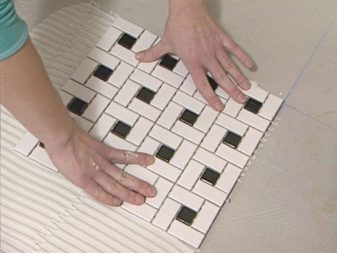
Beautiful examples in the interior
Bright green mosaics on the walls and a black and green version of the small-format checkerboard tiles on the floor create a special atmosphere in the room. In such a bathroom, you will definitely be able to properly relax and enjoy moments of relaxation.
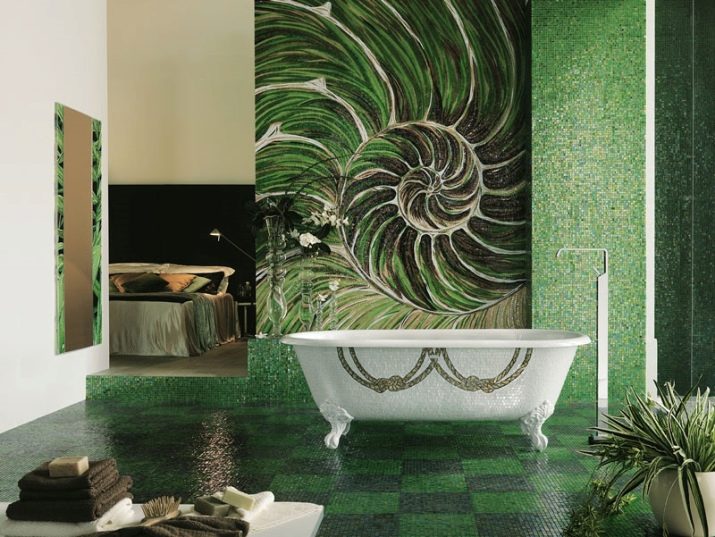
A classic example of combining mosaic walls with complex geometry with smooth tiles on the rest of the surfaces. The variegated décor is balanced by a matte white floor.
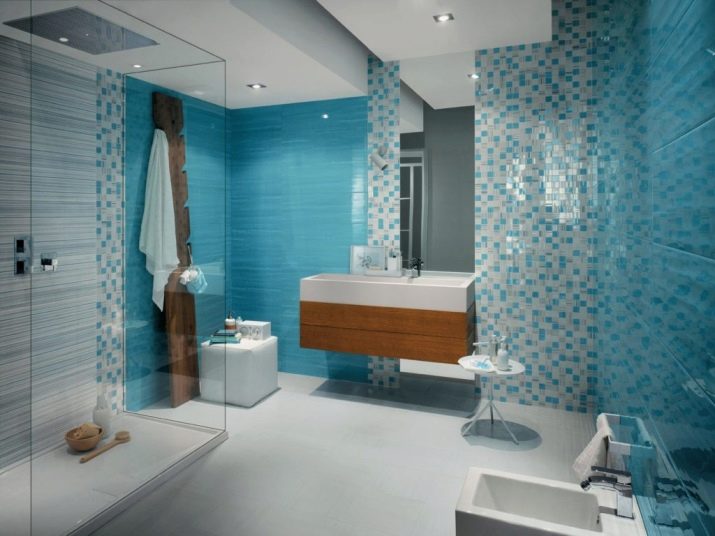
Striking gold motifs in the bathroom design. The mosaic is presented in a small volume, but it is she who is the brightest accent in the interior.
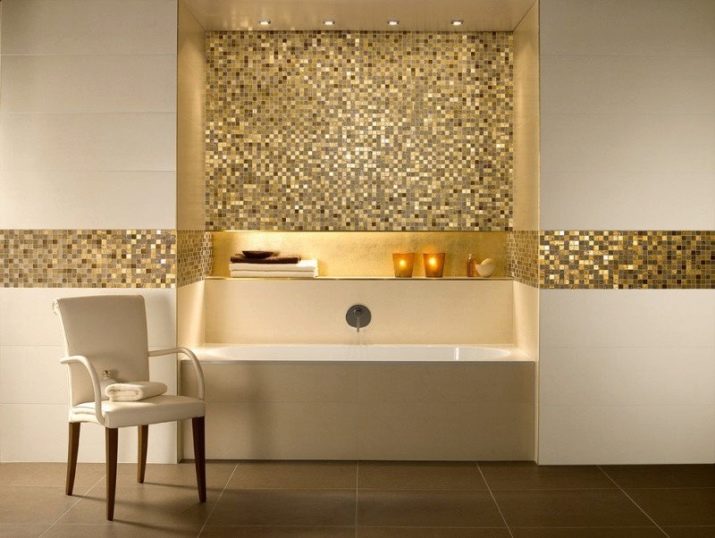
Learn more about mosaics in the following video.








